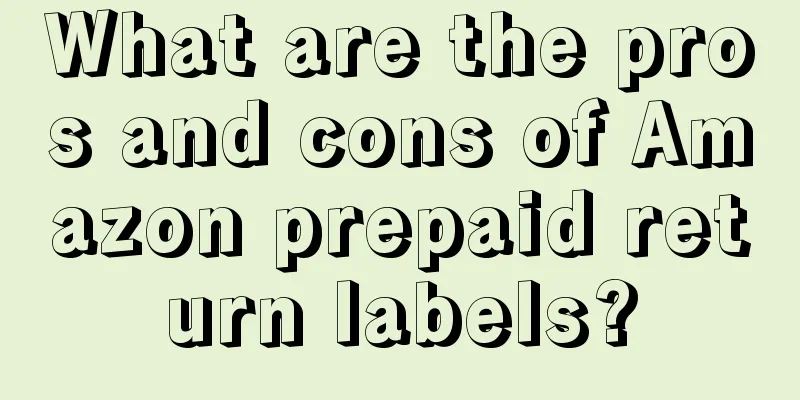How much is Amazon's overage inventory fee? What is the calculation logic?

|
Merchants who open stores on Amazon should be familiar with over-aged inventory. As a problem that needs to be dealt with within the store, there are still many derivative problems of over-aged inventory, such as how to properly handle these over-aged inventory products and how much is the storage cost of over-aged inventory? Let's learn about it below. How much are Amazon’s overage inventory fees? You will see this explanation on the help page of the seller platform: If the seller stores more inventory than the limit, Amazon will charge an overage storage fee for the excess. The amount of the overage fee depends on the number of days you exceed the storage limit, which is based on the average daily volume of all the space your inventory occupies in Amazon's fulfillment centers that exceeds the storage limit. If the inventory you store in Amazon's fulfillment centers exceeds the storage limit on any day of the month, you will be required to pay the overage storage fee. Even if your inventory level later drops back to within the storage limit allocated for the month, you will still be required to pay the fee. The amount of the overage storage fee depends on the number of days you exceed the storage limit. US station: $10/cubic foot (about $357/cubic meter) UK station: 7.8 pounds per cubic foot (about 279 pounds per cubic meter) France/Germany/Italy/Spain: 320 Euros/cubic meter Japan Station: 31,727 yen/cubic meter The excess storage charge is based on the excess days and volume. How do you understand the above passage? Let us explain it in detail through an example. Summarize the above paragraph into the calculation formula for excess storage fee: Monthly storage overage fee = current overage value × (monthly fee per cubic meter or cubic foot) or Monthly storage excess fee = average daily excess value × (monthly fee per cubic meter or cubic foot) or Monthly storage overage fee = current overage value × average daily overage fee × number of charging days in the month *Current overage value = current usage - current limit *Average daily excess value = current excess value / current excess days *Average daily overage rate = (monthly charge per cubic meter or cubic foot) / number of days in the month Taking the US site as an example, the calculation logic is explained with the help of a virtual case of seller Xiaohua: Assume that Xiaohua's standard-size commodity storage limit starting July 1 is: 1,000 cubic feet ➤ July 1st - July 4th The current inventory space occupied by Xiaohua's standard-sized products is: 1,100 cubic feet The storage excess value is: 1100-1000=100 cubic feet. From July 1 to July 4, Xiaohua's storage excess value totals 100 cubic feet x 4 days = 400 cubic feet. ➤ July 5th - July 31st On July 5, Xiaohua created a removal order to remove 80 cubic feet of inventory. At this time, the inventory occupied space is: 1020 cubic feet The storage excess value is: 1020-1000=20 cubic feet. From July 5 to July 31, Xiaohua's storage excess value totaled 20 cubic feet x 27 days = 540 cubic feet. Xiaohua's average daily storage excess in July is: (400+540)/31 days = 30.322 cubic feet The storage excess fee for July is: 30.322 x 10 = $303.22 The overage inventory fee on Amazon is also called the overage inventory surcharge. Many people are also accustomed to calling it the long-term storage fee. It used to be a fixed fee, but later it was changed to a tiered fee model. The longer the overage inventory is occupied, the more expensive the subsequent fees will be. Recommended reading: How does Amazon improve conversion rates? What are the methods? Why is Amazon's automatic advertising not exposed? What is the reason? How many SKUs can be listed on Amazon at most? What should I pay attention to when creating products? |
<<: How to set up a Shopee add-on discount? Which products are suitable for add-on discounts?
>>: What is the Shopee package offer? How to choose the product category?
Recommend
Customer experience: How to attract consumers to “go shopping” in the era of online shopping?
In an era of online shopping, how can we attract c...
The short drama industry welcomes new forces. How do the old big companies stir up the trillion-dollar market?
The short drama industry has recently ushered in a...
Xiaohongshu is connected with Meituan, and Xiaohongtuan is launched in internal testing
Following Xiaohongxing, Xiaohongmeng and Xiaohongl...
Chiikawa craze among young people: from emojis to "plastic surgery"
Chiikawa, with its cute image and unique worldview...
Compared to physical products that are easy to go viral, how can “online products” create social currency?
The social currency of a brand is a tool for forgi...
Kimi chat's reward payment model has hidden secrets and has huge advantages compared to direct payment!
Since the rise of big models, their business model...
Daily News | ChatGPT can "connect to the Internet" again / Huawei launches a 1999 yuan mobile phone case / Wait until after the holidays? WeChat avatars are updated
🔄 ChatGPT welcomes another major update: it can &q...
The third data analysis method for experts: trend analysis
In the world of data analysis, trend analysis is p...
How to quickly register on shein? Registration review process
With the rise of cross-border e-commerce, Shein ha...
Don’t know what type of notes to write on Xiaohongshu? Read this article quickly!
Do you have no idea what type of notes to write wh...
Latest: WeChat Stores "Send Gifts" are on the rise, Taobao and Douyin have followed suit
WeChat's gift-giving function has officially b...
Is it necessary to bind a legal person to Amazon payment? What are the payment accounts?
Amazon merchants should all know that Amazon's...
How to open a cross-border e-commerce store at home? How to do it at home?
Cross-border e-commerce is aimed at the global mar...
How to co-create content under social marketing?
Introduction: The advent of the Internet big data ...
My 8 favorite sentences in May!
This article focuses on the excellent copywriting ...









